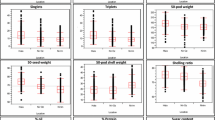Summary
Performance of a random array of recombinant inbred lines derived by single seed descent from five different source populations of Brussels sprouts (Brassica oleracea var. gemmifera) is presented. A total of 2,356 lines were tested in trials during 1985 and 1986. Three of the source populations were derived from double crosses between F1 hybrids. These hybrids show a considerable heterotic advantage over their inbred parents for the most important agronomic traits. The recombinant inbred lines performed, on average, less well than the parental inbred material, indicating that additive x additive genie interactions may make a significant contribution to the performance of current inbred material. Nevertheless, the very large variation among the recombinant inbred lines permitted many lines to be identified which outperformed the best parental inbred for all traits. Two lines outperformed the reference F1 hybrid, Gower, for an index that included marketable yield and quality. Consideration was also given to the dangers of misinterpreting phenotypically based proportions. Accordingly, response equations were used to ascertain the real genetic progress that was made. Advance seemed small when compared with the large heterotic effect, which is consistent with the segregation of a large number of loci. The distribution of the recombinant inbred lines was compared to predictions made from early generation trials. There was broad agreement but significant discrepancies existed which, it is suggested, may arise from the effects of genotype-environment interactions.
Similar content being viewed by others
References
Caligari PDS, Powell W, Jinks JL (1985) The use of doubled haploids in barley breeding, 2. An assessment of univariate cross prediction methods. Heredity 54:353–358
Duvick DN (1984) Genetic contribution to yield gains of US hybrid maize, 1930–1980. In: Fehr WR (ed) Genetic contributions to yield gains of five major crop plants (special publication number 7), Crop Science Society of America, Madison WI, pp 15–47
Eggleston MMP (1985) The breeding of inbred lines in populations of Lolium perenne and Drosophila melanogaster. PhD Thesis, Faculty of Science and Engineering, University of Birmingham
Falconer DS (1981) Introduction to quantitative genetics, 2nd edn. Longman, London New York
Jinks JL (1983) Biometrical genetics of heterosis. In: Frankel R (ed) Heterosis. Springer, Berlin Heidelberg New York, pp 1–46 (Monographs Genetics 2)
Jinks JL, Pooni HS (1976) Predicting the properties of recombi nant inbred lines derived by single seed descent. Heredity 36:253–266
Johnson AG (1984) Breeding inbred varieties of Brussels sprouts. Sci Hortic 35:45–49
Kearsey MJ (1984) A biometrical approach to vegetable breeding. Proc 5th Meet Eucarpia Sect Biomet Plant Breed 99–111
Ockendon DJ (1984) Anther culture in Brussels sprouts (Brassica oleracea var. gemmifera). I. Embryo yields and plant regeneration. Ann Appl Biol 105:285–291
Rogers WJ, Kearsey MJ, Smith BM (1987) The feasibilaity of producing inbred rather then F1 hybrid cultivars in Brussels sprouts: predictions from early generations. Ann Appl Biol 111:677–688
Schnell FW (1974) Trends and problems in breeding methods for hybrid corn. XVI British Poultry Breeders Roundtable 1–17
Setter AP (1988) Predicting the results of breeding programmes in outbreeding species. PhD Thesis, Faculty of Science, University of Birmingham
Smith BM, Rogers WJ, Kearey MJ (1985) The feasibility of producing inbred rather than F1 hybrid cultivars in Brussels sprouts: a preliminary genetical analysis and choice of material for inbreeding. Ann Appl Biol 107:87–99
Thomas WTB, Tapsell C, Powell W (1986) The application of cross prediction in spring barley breeding. Proc 6th Meet Eucarpia Sect Biomet Plant Breed 90–103
Werner CP, Smith BM, Kearsey MJ (1986) Tests of inbred predictions in Brussels sprouts. Proc 6th Meet Eucarpia Sect Biomet Plant Breed 125–139
Wricke G, Weber WE (1986) Quantitative genetics and selection in plant breeding. de Gruyter, Berlin
Author information
Authors and Affiliations
Additional information
Communicated by A. R. Hallauer
Rights and permissions
About this article
Cite this article
Werner, C.P., Setter, A.P., Smith, B.M. et al. Performance of recombinant inbred lines in Brussels sprouts (Brassica oleracea var. gemmifera). Theoret. Appl. Genetics 77, 527–534 (1989). https://doi.org/10.1007/BF00274274
Received:
Accepted:
Issue Date:
DOI: https://doi.org/10.1007/BF00274274




